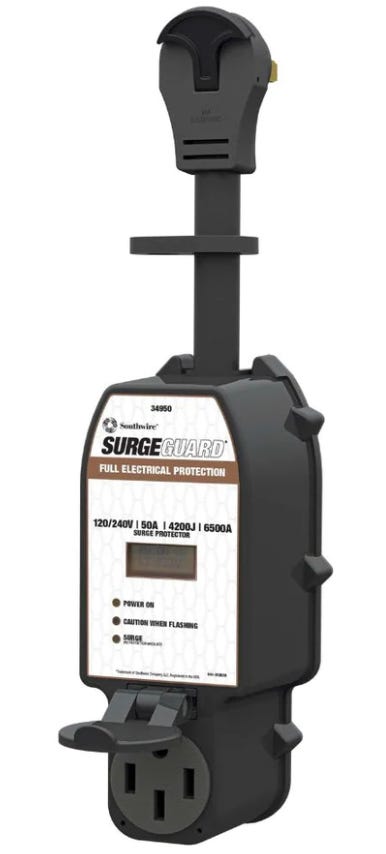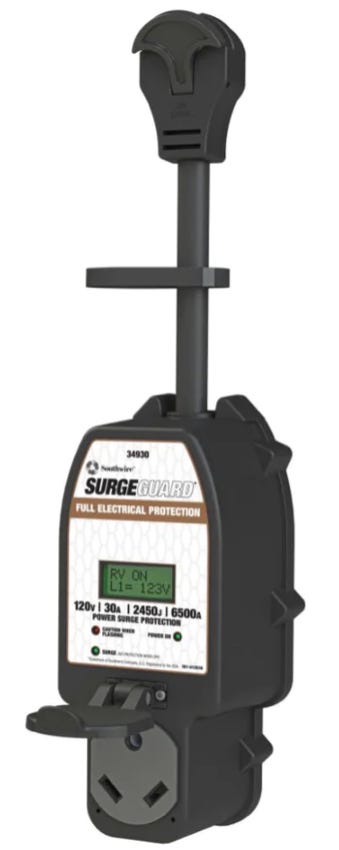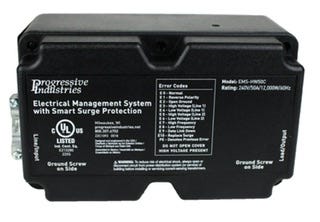Can I add a second surge protector?
Who shall guard the guards?
Dear Mike,
Thanks for your No~Shock~Zone articles! I am a big fan. I have a technical question based on an issue raised by a fellow camper. I have a Progressive Industries Surge Protector (EMS-HW50C Portable Electrical Management System) on my 50A diesel pusher, and I also use a Camco Dogbone RV Circuit Analyzer with integrated surge protection and fault indication (125/250V 50M/50F Amp) for use at the pedestals.
I got the Camco circuit analyzer primarily as a way to monitor the quality and safety of the power of the pedestal, but the unit also provides surge protection. I’ve had a fellow camper suggest that putting a second surge protector on the pedestal is a bad idea, since I already have a surge protector on the rig. Is putting a second surge protector at the pedestal okay, or a bad idea? —Michael C.
Dear Michael C,
Actually, it’s a very GOOD idea. You’re adding additional joules of surge protection at the pedestal, which will also help keep lightning spikes out of the inside of your RV. Plus you can use the portable surge protector to do a preliminary check of the campground power BEFORE you accept the campsite….
What if you don’t already have an Advanced/EMS Surge Protector?
However, for any of you who don’t have an intelligent/EMS surge protector like your EMS-HW50C which checks for high and low voltage as well as open grounds, let me suggest that instead of something like a basic Camco circuit analyzer, you get an intelligent surge protector for the pedestal such as the Surge Guard 34950 (50-amp) or 34930 (30-amp) unit. This will not only increase the joules of spike protection due to the extra MOV devices, it will add downstream open-neutral testing and shutdown on the 50-amp version.


As a power pre-check before-making-camp procedure (before you pull in your RV, level it and connect up the water, etc.), I’m recommending that everyone first use a NCVT (Non Contact Voltage Tester) such as the Southwire 40116N to check the campsite pedestal to make sure the box itself doesn’t have a stray voltage. (Yes, I’ve had several emails in the last month with this really dangerous condition.)
Don’t accept a hot-skin voltage!
If the pedestal does have a stray voltage, DO NOT accept the campsite and move on. If it’s OK (shows no voltage on the outside of the pedestal box), then plug in your intelligent surge protector and check the outlet for open ground, reversed polarity and reasonable voltages (102 to 132 is considered acceptable, but I think a range of 105 to 128 is safer). If the voltage is a little low you might be OK using this pedestal as long as you don’t run hot plates and air conditioners. And if the polarity is reversed you’re still probably safe, but the campground should be notified and repair the problem quickly.
Don’t accept an open ground!
However, if the outlet ground is open, then DO NOT accept the campsite and ask to move to another one after notifying the campground of the problem. Bypassing your surge protector on a pedestal that has an open or hot ground is putting your life and the lives of anyone else touching your RV in danger, so please take this seriously.
Where to buy a Southwire Surge Protector (and lots of other cool RV stuff).
I’ve started an affiliate program with TechnoRV which does pay me a small commission on products that you purchase from them. I’ve know Eric and Tami for years, and their customer service and educational programs are fantastic. That’s something you don’t get from Amazon or eBay (as much as I like both of them). So click the TechnoRV logo above and take a look around. Some of their electrical products were independently reviewed by me before TechnoRV became dealers for them. For a direct link to their website click HERE.
Let’s play safe out there…. Mike








I have a surgeGuard 40350RVC on my class A motorhome and the coach itself has a full EMS, including load shedding, wait time for the A/C etc. Since the 40350 has the high and low volt monitoring, etc, I have added only the basic surge protector to spare the 40350, since surge protection is the only thing that gets "used up".
Do you agree that in this situation, the basic surge protection is enough?
I used to use a cheap pedestal type surge protector, but that’s all it did…protect against surges. Did nothing to protect my RV from low power conditions, which I encountered at a cheap CG resulting in my delicate fridge electronics being fried. Installed a hardwired electrical management system and it has saved our bacon on numerous occasions.